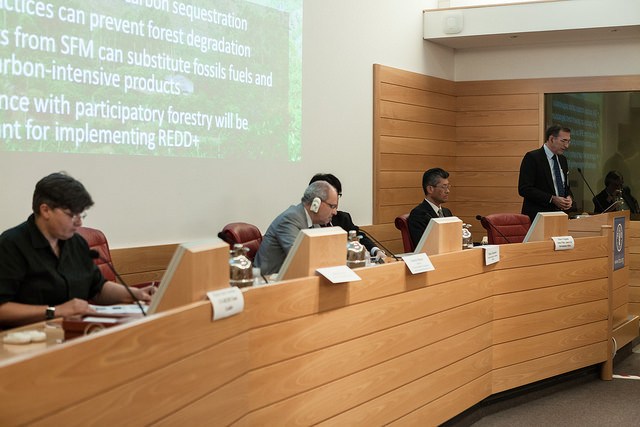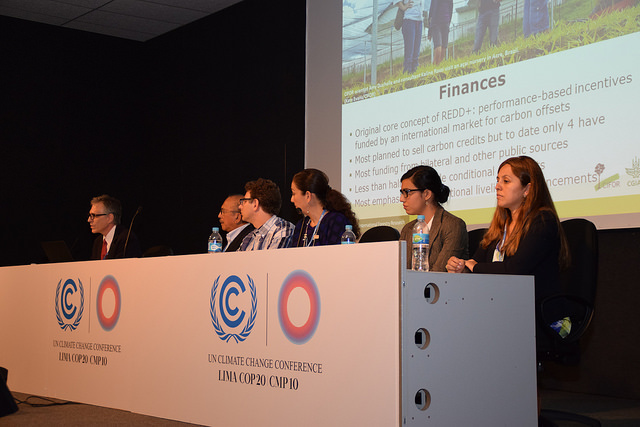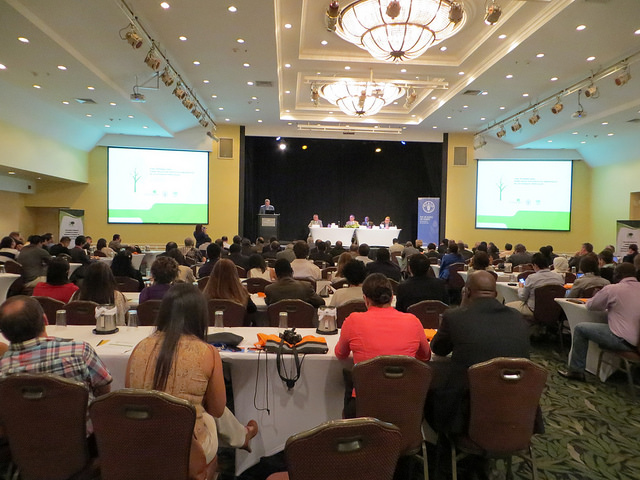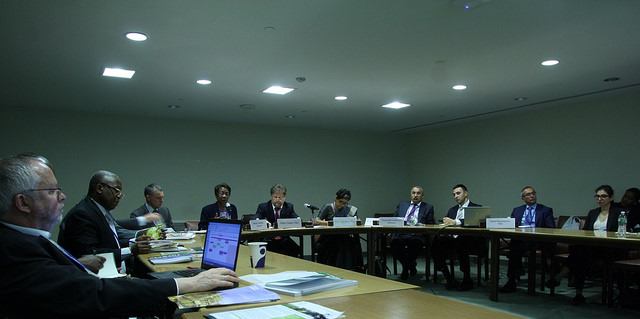
by Vijay Kolinjivadi
When people take to the streets and demand climate justice, they expect their elected leaders to step up and address the drivers of what is clearly the largest global crisis humanity has ever faced. However, the so-called “solutions” that were brought to the table for COP 21 in Paris last week are anything but—instead they deflect attention away from consumption patterns linked to the burning of fossil fuels.
These strategies are devised by powerful corporations and government partners as a literal and metaphorical “smokescreen” for the real drivers of deforestation and carbon release to the atmosphere, including monoculture expansion of palm oil and soybean, oil and minerals extraction, industrial logging and mega-infrastructure projects.
REDD+ is a cost-shifting mechanism, a potential get-rich scheme for local elites, and a placating strategy to prepare the broader landscape for the accumulation of “new” capital.
One of the most subtle and sinister “solutions” promoted by the UN, the World Bank and other global development institutions is REDD+, which stands for (Reducing Emissions from Deforestation and Forest Degradation). The “+” is meant to incorporate other environmental or development priorities, including biodiversity conservation and poverty alleviation. US$ 10 billion has been pledged for addressing climate change through REDD+, though not many have heard about what this strategy is all about.
Some people say REDD+ sends a signal that safeguarding forests through performance-based payments is key to combatting climate change. Maybe they are right, but the way in which REDD+ is framed also paves the way for appropriation of the landscape while reducing the capabilities of forest peasants to take control over their own development futures. While forests protection plays a vital role for maintaining critical ecological processes and the well-being of the people that depend on them, REDD+ does not place the forest at its heart. It is instead a cost-shifting mechanism, a potential get-rich scheme for local elites, and a placating strategy to prepare the broader landscape for the accumulation of “new” capital.
REDD+ is premised on reducing carbon emissions from deforestation. While it is true that deforestation amounts to 25-30 percent of carbon emissions and is a major factor influencing climate change, carbon sequestered by trees is vastly different from sequestering carbon by keeping fossil fuels in the ground. Firstly, it is a challenging endeavour to measure carbon emissions in an accurate and transparent manner, with many measurements tens of thousands of tons of CO2 off the mark.
Secondly, trees are unstable and only temporary repositories of sequestered carbon, since the carbon they store will eventually be returned to the atmosphere. Re-release of carbon might occur much faster than “expected” due to climate-induced forest fires. Indeed, just three weeks of raging forest fires in Indonesia have released more CO2 than Germany’s entire annual emissions.
It’s as though we are placing the blame on (remaining) tropical forests for not sequestering enough carbon when it is in fact actual carbon emissions through the burning of fossil fuels which has brought us to the brink of the climate catastrophe we face. Of course, it is all the more easy to place the burden on tropical forests for solving our climate problems when they conveniently reside in countries out of sight and out of mind from where carbon-intensive development paths occur, and of course where costs of taking responsibility for climate change are the cheapest. This is an all too-convenient recipe for shifting environmental costs and accountability of actions.

REDD+ projects are carried out by businesses or development NGOs in industrialized countries who pay communities residing in tropical forest areas, mainly in the Global South, to prevent forest destruction from happening, whereby it must be evident that deforestation would otherwise happen if payments are not forthcoming. The amount of payment provided by the industrialized country partner reflects the tonnage of carbon, linked to its price on the global carbon market, which is saved from being released into the atmosphere due to forest protection.
Damage to the environment and rehabilitating the damage both become socially justifiable market opportunities to spur economic growth.
The stipulation that the payment provided for forest protection and carbon sequestration has prevented the forest from being destroyed and that the forest continuously be safeguarded from destruction is important for the industrial country funders, who aim to score carbon-credits from the deal. These credits serve as “rights to pollute”—something of a reward for having done a good deed, in this case for paying to supposedly prevent deforestation from occurring. The incredulous, almost farcical nature of this arrangement becomes disturbingly obvious. The polluting country or company, who has been responsible for the majority of carbon emissions up until now, suddenly has the right to continue burning fossil fuels and releasing CO2 as before.
The tropical forests of the Global South are a precious new commodity to squabble over, this time with billions of dollars backing the potential spoils and rich countries as new rights-holders of land locked away for carbon offsetting the continued economic development of rich countries. This is the same image of colonization that we’ve seen time and again, but this time with a surreptitiously green face.
As social anthropologist Melissa Leach and colleagues of the University of Sussex have argued, mainstream economics has successfully attributed value both in the exploitation of the environment and natural resources for growth in manufactured goods, but in recent times have also determined the potential for market creation in the repair of the environment in the name of “sustainability.”
This is the same image of colonization that we’ve seen time and again, but this time with a surreptitiously green face.
This new economic driver of environmental repair combined with the classical economic driver of resource extraction and resulting environmental degradation work in concert to extract the maximum value out of nature irrespective of whomever or whatever is in the way. In this way, damage to the environment and rehabilitating the damage both become socially justifiable market opportunities to spur economic growth.
REDD+ would be flawed even if the payments were targeted to major drivers of deforestation in the Global South, namely industrial-scale agriculture for commodities such as soybean and palm oil. This is because overall carbon stocks would not be reducing—which is ultimately what is so badly needed if we are to prevent dangerous climate change from occurring. Without underestimating the important role that tropical forests could play in storing carbon, it would make far greater sense to curtail the burning of fossil fuels and other carbon-emitting activities and prioritize actions to halt carbon emission at the source.
However, what is so heinous about this situation is that REDD+ projects do not target those responsible for large-scale deforestation, but instead target poor shifting cultivators whose forest-dwelling livelihoods and associated socio-cultural knowledge systems and practices become ‘priced-out’ by the market because they are too low to compete with, in this case, the value of carbon for Western countries to keep polluting.
For forest-dwelling communities who depend on forest areas for food security, housing, medicines and fodder, REDD+ projects mean that meeting basic human needs become all the more harder- a tough and very unfair price to pay for people who had very little to do with the climate crisis in the first place.
As a recent report by GRAIN highlights, REDD+ proponents place the blame for deforestation on peasants under the guise of “slash-and-burn” farming practices, yet conveniently ignore and even simultaneously support the industrial palm-oil plantations, infrastructure projects and intensified agriculture strategies that are the real drivers of tropical deforestation.
The gospel of neoclassical economics explain this apparent contradiction, since the “opportunity costs” of paying off peasants for deforestation is overwhelmingly lower than halting the real drivers of deforestation. As the report emphasizes, this is a way for industrialized countries to pay very little, yet say they are doing something to combat climate change, while failing to reduce their historical and continued contributions to deforestation through the export of commodity crops and for mega-infrastructure projects largely to service resource extraction operations.

For forest-dwelling communities who depend on forest areas for food security, housing, medicines and fodder, REDD+ projects which lock forests away for carbon mean that meeting basic human needs become all the more harder—a tough and very unfair price to pay for people who had very little to do with the climate crisis in the first place. Meanwhile, peasants desperate to feed their children continue venturing into the forest, risking fines and imprisonment. Where attempts, in response to donor requirements, are made by REDD+ project proponents to facilitate livelihood transitions to sustainable agriculture or ecotourism, project funds are often limited and short-lived, leaving communities with less capabilities than before the project started.
Just when you might wonder how this situation could get any more flawed, it doesn’t stop there! The strict contract obligations of REDD+ effectively immobilize peasant communities from achieving basic human needs of food and fodder for the duration of the project period (upwards of 10 years or more) while providing them “payment” which gets siphoned away through a cascading chain of carbon companies, auditors establishing certification standards, international consultants, conservation NGOs and “green” venture capitalists from primarily industrialized countries all seeking to grab a piece of the lucrative REDD+ pie before it ever reaches the community.
Contracted communities become legally bounded to follow suit with the terms of the carbon buyers in the West, even as many of the project documents are written in English rather than in local languages and introduce a seemingly foreign value of the forest for its ‘carbon’ which has little if any meaning for forest communities.
As this process unfolds, the already marginalized and now REDD-trapped forest communities are no longer a hindrance to the expansion of industrial agriculture, the mega-infrastructure projects, rare earth mineral exploration or commodity crop monocultures. Thus, despite having rights to the land, these rights become effectively weakened, since under REDD+, it is the carbon buyers who decide how the land is to be used and not the rightful owners of the land.
In essence, REDD+ sets the stage for a resource grab “free for all” under a swish green banner, while demonizing marginalized peoples as threats to the forest and ultimately inducers of climate change.

The “Cartel of the Parties”
So who are these REDD+ proponents who are advancing this climate “solution” at COP 21 in Paris? It is startling to note that those groups that society has tasked with solving humanity’s social and environmental crises are the foremost advocates for REDD+.
WWF, Conservation International, The Nature Conservancy and the International Union for the Conservation of Nature (IUCN) are some of the leading proponents as they team up with some of the world’s most notorious climate polluters including Unilever, Syngenta, Monsanto, McDonalds, Walmart and Nestlé, whose business activities depend on actively promoting wholesale deforestation and depletion of soil fertility through dependence on commodity crops such as soybean and palm oils.
In this latest stage of capital accumulation, green is the new gold for the stock brokers of the global North who view tropical forest regions of the Global South as value that must be reaped and brought back home.
Another major player is the private investment arm of the World Bank, the International Finance Corporation (IFC), which paves the way for these corporations to access previously unexploited lands through promises of new markets and “environmental stewardship” for corporate social responsibility via carbon offsetting through REDD+ projects, among other similar ploys.
As James Fairhead and colleagues at the University of Sussex have suggested, the Conference of the Parties is in reality more of a “Cartel of the Parties” involving international development banks, conservation NGOs, the private sector and government agencies who are all dead-set on advancing the “green” economy, through which nature presents itself as a lucrative investment opportunity to permit market expansion and access deeper into the commodity frontier while paving the way for more traditional resource extractivist markets to gain a stronger foothold around the world. In this latest stage of capital accumulation, green is the new gold for the stock brokers of the global North who view tropical forest regions of the Global South as value that must be reaped and brought back home.

Demanding an end to neo-colonialism
What then does it take to demand action on climate change for COP 21? What should COP 21 really be about? Well, besides the fact that strong measures to curtail climate change should have been made at COP 1, rather than waiting for 20 years, here are five forgotten agendas:
1. Limiting land-use practices and industrial activities that add further Greenhouse gas emissions into the atmosphere and which depend on industrial agriculture involving the over-application of nitrogen and phosphorus fertilizers, insecticides and herbicides that deplete soil nutrients and damage water sources. These practices originate from over-developed countries whose demand-driven development trajectories have meant outsourcing industrial food production and resource extractive activities throughout the world to satisfy grossly unsustainable domestic consumption.
2. By turns, this means that an overhaul of the current industrial food trading system must be at the heart of any climate deliberation. Agri-business corporations with their herbicide-infused genetically-modified seeds must be heavily regulated by governments to prevent dangerous climate change from occurring. As an important positive spinoff, regulating these companies would also diversify the food system and open opportunities to give living-wages back to millions of farmers around the world.
3. A climate solution must put the self-determination, food sovereignty and basic needs of resource-dependent communities at the forefront of any sustainable natural resource management initiative. This means resource use, access, and management rights must be prioritized for forest-dwelling communities to collectively manage their own resources, facilitated by domestic policies which encourage sustainable soil management. In order to achieve this aim, it is absolutely crucial to be clear as to who wins and who loses from strategies such as REDD+ or any other proposed “solution” that emerges from the Paris agreement. Rather than seeking climate policy panaceas, closer historical, socio-cultural and political scrutiny is required to understand when and where any given strategy can be successful and what kinds of unintended repercussions might occur as a result of its widespread promotion and implementation.
4. Dismantling the myth of the “green economy” that, rather than addressing the drivers of climate change, only serves to deflect blame away from those perpetuating climate crimes while permitting new opportunities to exploit marginalized communities as indentured labour to service new markets for nature. Falling under this strategy includes the increasing appropriation of agricultural land for biofuels, which creates the same alienating effects on communities who depend on their land for food security. Similarly problematic are investments in green start-up technologies by green venture capitalists who demand double-dividend returns in the name of financing an energy-efficiency revolution. Such an approach fails to come to terms with the Jevon’s Paradox: that increasing improvements in energy efficiencies become quickly over-compensated by ever-increasing consumptive demands fueled by unchecked economic growth.
5. Rather than permitting over-developed regions of the world to continue exploiting resources and people for their benefit, solutions that emerge through indigenous knowledge and non-Westernised knowledge systems are critical for re-balancing the social-ecological equilibrium of our planet. This socio-cultural conundrum is substantially more challenging than addressing the global climate crisis, as it requires an active process of “unlearning” what the West has taught the world, often through systems of oppression, as to what constitutes “development.”
Anything short of seriously considering these five points will once again result in a political circus that reinforces neoliberal strategies and colonial geo-political manoeuvres. If citizens of the world demand fair and just solutions to address climate change, we must not allow our elected leaders and national negotiators to blindly advocate for strategies such as REDD+. The devil is really in the details!
Vijay Kolinjivadi, PhD, is a researcher of the Ecological Economics research group at McGill University. His research has led him to report on the dangers of commodifying nature and to identify how and when human-nature relationships can be resilient in the face of inevitable change. He enjoys traveling and reading in grassy meadows among other things.
A version of this article was originally published on truthout.